Review of “Whole Body Listening Larry at School” by Kristen Wilson and Elizabeth Sautter
This book is the sequel to “Whole Body Listening at Home”. Personally, I prefer to start the instruction on holistic listening with this book rather than the “Whole Body Listening at Home” only because it seems like such an integral and critical part of school learning. In addition, comments like “You need to do better listening,” and “Pay attention” often occur more frequently in the classroom than at home.
I think, what this book does, like most other Social Thinking Curriculum materials, is to break down an abstract concept like “better listening,” “paying attention” into concrete segments using simple child-friendly language and pictures. When I first reviewed the book, I have to admit I was a little disappointed I hadn’t thought of this myself. It seems obvious and intuitive. The book uses school-age characters to describe Whole Body Listening. Whole Body Listening, according to the book includes using your eyes, ears, hands, feet, brain, and heart to listen. The situations used to teach how each of these body parts is actively involved in listening are easily relatable for most children. Breaking down the process of active listening by explaining the role of each individual body part makes so much more sense than simply asking the child to show “good listening” since the book actually explains what that means.
For the lesson, I took my time reading the book with my client. We discussed each picture in detail talked about what she saw and what Lea and Luka (the characters in the book) should do differently. We also did some role-play to make it fun and engaging. A critical piece that the authors discuss is making a link between the behavior to the feelings and emotions of others. Talking about how the listener feels when you are not listening with your whole body was challenging for my client. But making that connection repeatedly throughout the book discussion did eventually pay off. The Social Thinking website has a free download that could be incorporated in the lesson. It is a coloring page with pictures of all the body parts involved in Whole Body Listening.
I used several weeks to really hone in the concept of Whole Body Listening. I was surprised with how many activities and ideas were available online to incorporate into the lesson. I thought it might be helpful to list the resources I used to make it easier for readers to plan their “Whole Body Listening” lessons.
- In addition to the poster/ coloring page available on www.socialthinking.com, I used Mr. Potato Head to reinforce the concept. While the eyes, ears, hands, and feet were available, I wanted to also include the heart and the brain. So I cut out a heart shape from cardstock and used Velcro to attach it on Mr. Potato Head. I also used an image of a brain. When my client added each piece to Mr. Potato Head, she had to explain what body part needs to do for Whole Body Listening.
- I also used the “Biscotti Kid” video that is available on YouTube. It is a hilarious 5 minute video by Sesame Street ©. The video demonstrates how hard Whole Body Listening is for Cookie Monster, but finally he gets it and wins a black and white cookie belt. It is an excellent kick off for a discussion on Whole Body Listening and why it can be challenging sometimes. I used it to list some of the common distractions in my client’s classroom.
- I also used the Whole Body Listening portion of Kathleen Pedersen’s “Monster Fun! Teaching Manners and Expectations. It is a free digital download on TeachersPayTeachers. It is a fun book with colorful images that review all the body parts involved in Whole Body Listening. This is Kathleen’s blog: http://growingkinders.blogspot.com.
- “Howard B Wigglebottom Learns to Listen” by Howard Binkow is a book Howard, who gets into a lot of trouble for not listening. It is an excellent accompaniment to the Whole Body Listening lessons. The “We Do Listen Foundation Media Center” has an online animated version of the book with excellent sound effects. The website to access the online video is https://wedolisten.org/?.
Overall, I think it is an excellent book. I would highly recommend it. The book is simple, but fun and engaging. It makes an abstract concept concrete and easy to understand, even for younger preschool aged children. The handy poster is a great reminder to have in your clinic or classroom.
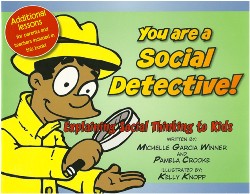 Getting started with the Social Thinking Curriculum by Michelle Garcia Winner is always a challenge. Most of us, Speech-Language Pathologists, fall under two distinct categories: 1) “Read first Therapists” that like to read and study a program until it we can recite it in our sleep before we will begin to implement it on our students, 2) “Try it out first Therapists” that will try to figure out the program while we implement it on our students.
Getting started with the Social Thinking Curriculum by Michelle Garcia Winner is always a challenge. Most of us, Speech-Language Pathologists, fall under two distinct categories: 1) “Read first Therapists” that like to read and study a program until it we can recite it in our sleep before we will begin to implement it on our students, 2) “Try it out first Therapists” that will try to figure out the program while we implement it on our students.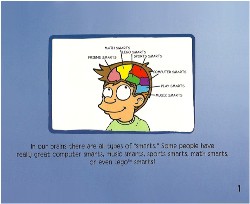
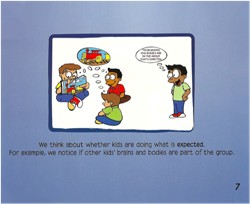 Versus
Versus 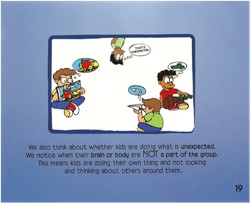
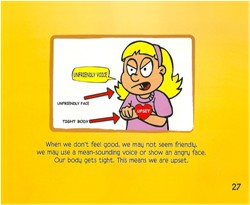 The book also explains “being upset” in explicit physical terms (mean sounding voice, angry face, body gets tight) so children can identify their own states when they get upset.
The book also explains “being upset” in explicit physical terms (mean sounding voice, angry face, body gets tight) so children can identify their own states when they get upset.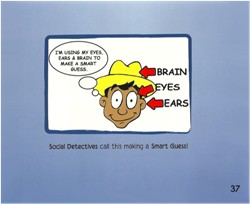 Another challenge a lot of my little ones have is identifying and differentiating between peers who are nice and friendly and others who say or do mean things. The book has tables (page 44 and 45) to help the child identify and list characteristics of a “nice person” and a person who is “not nice to talk to.” In addition, the book also has a glossary with definitions of the Social Thinking vocabulary for quick reference. The book also includes three lesson plans at the end of the book for “Expected Vs Unexpected Behaviors,” “Social Spy,” and “Social Detective.”
Another challenge a lot of my little ones have is identifying and differentiating between peers who are nice and friendly and others who say or do mean things. The book has tables (page 44 and 45) to help the child identify and list characteristics of a “nice person” and a person who is “not nice to talk to.” In addition, the book also has a glossary with definitions of the Social Thinking vocabulary for quick reference. The book also includes three lesson plans at the end of the book for “Expected Vs Unexpected Behaviors,” “Social Spy,” and “Social Detective.”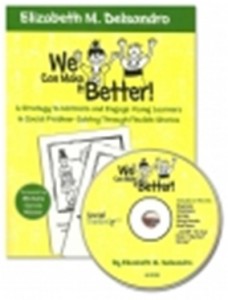 A majority of my caseload includes preschool and early elementary aged students. Many of them are diagnosed with Autism or demonstrate social skill deficits. If you’re like me and work with the younger students, you know how hard it is to find social skill programs that are structured, but still age appropriate. For the last year or so, the Social Thinking Curriculum has been the go-to program for many therapists to build social skills. However, finding materials that are appropriate for this age group has always been a challenge. In many settings including the public schools the Social Thinking curriculum isn’t incorporated until upper elementary or middle school years. Does that mean that the Social Thinking Curriculum isn’t appropriate for the preschool age group? In my opinion the preschool and early elementary age group is ideal to begin teaching the Social Thinking Curriculum. Introducing the Social Thinking vocabulary and concepts early on makes them a part of their everyday lives and routine. It does present unique challenges though: 1) teaching the vocabulary in ways that makes sense to younger students and 2) preparing lessons that are age appropriate, engaging and flexible.
A majority of my caseload includes preschool and early elementary aged students. Many of them are diagnosed with Autism or demonstrate social skill deficits. If you’re like me and work with the younger students, you know how hard it is to find social skill programs that are structured, but still age appropriate. For the last year or so, the Social Thinking Curriculum has been the go-to program for many therapists to build social skills. However, finding materials that are appropriate for this age group has always been a challenge. In many settings including the public schools the Social Thinking curriculum isn’t incorporated until upper elementary or middle school years. Does that mean that the Social Thinking Curriculum isn’t appropriate for the preschool age group? In my opinion the preschool and early elementary age group is ideal to begin teaching the Social Thinking Curriculum. Introducing the Social Thinking vocabulary and concepts early on makes them a part of their everyday lives and routine. It does present unique challenges though: 1) teaching the vocabulary in ways that makes sense to younger students and 2) preparing lessons that are age appropriate, engaging and flexible.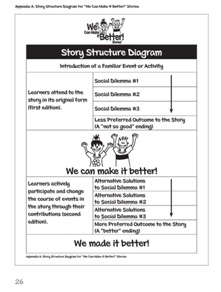 Appendix A describes the story structure. The first edition contains the social dilemmas, while the second provides solutions so the ending is a preferred ending.
Appendix A describes the story structure. The first edition contains the social dilemmas, while the second provides solutions so the ending is a preferred ending.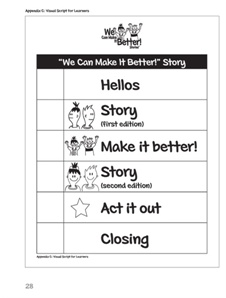 Appendix C provides a visual script for the lesson.
Appendix C provides a visual script for the lesson.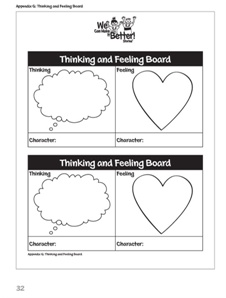 Appendix G provides a visual link between people’s thoughts and their feelings. This could be a very powerful and versatile tool. It could be used for far more activities than just the lessons in this program.
Appendix G provides a visual link between people’s thoughts and their feelings. This could be a very powerful and versatile tool. It could be used for far more activities than just the lessons in this program.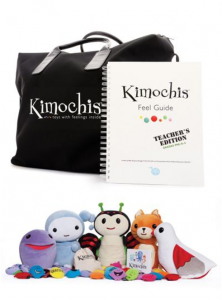 After 11 years in the field, I finally came across a curriculum that made teaching emotions a fun and positive learning experience. I was fortunate enough to be able to attend a presentation by Diann Grimm, M.A., CCC-SLP, Ed. S. on the Kimochi Curriculum. Kimochis in Japanese mean feelings. The program incorporates Kimochi characters with a pocket to place their Kimochis (emotions). Each Kimochi is a soft pillow with the feelings printed on one side and the corresponding facial expression on the other side. Using the Kimochis in conjunction with the feelings lessons as a part of the curriculum allows the children to learn to identify and express their emotions in a safe and focused manner. It fosters Social-Emotional Learning (SEL) which is a critical adjunct to the Social Thinking ® curriculum proposed by Michelle Garcia Winner. The adorable toys and the fun and child-friendly curriculum is a great way to support positive behavior, self awareness, social awareness, self management, relationship skills and decision making. It appears that some of the early research using this curriculum has shown positive results for children with Social-Emotional Learning difficulties (e.g. children on the Autism Spectrum). In addition, this curriculum has also been used for typical children in general education classrooms. I am so pleased and excited to offer the Kimochi Curriculum as a part of the Social Thinking groups. I think it will be an important piece to the puzzle that addresses the “Feelings-Communication-Behavior link” that Diann Grimm talks about.
After 11 years in the field, I finally came across a curriculum that made teaching emotions a fun and positive learning experience. I was fortunate enough to be able to attend a presentation by Diann Grimm, M.A., CCC-SLP, Ed. S. on the Kimochi Curriculum. Kimochis in Japanese mean feelings. The program incorporates Kimochi characters with a pocket to place their Kimochis (emotions). Each Kimochi is a soft pillow with the feelings printed on one side and the corresponding facial expression on the other side. Using the Kimochis in conjunction with the feelings lessons as a part of the curriculum allows the children to learn to identify and express their emotions in a safe and focused manner. It fosters Social-Emotional Learning (SEL) which is a critical adjunct to the Social Thinking ® curriculum proposed by Michelle Garcia Winner. The adorable toys and the fun and child-friendly curriculum is a great way to support positive behavior, self awareness, social awareness, self management, relationship skills and decision making. It appears that some of the early research using this curriculum has shown positive results for children with Social-Emotional Learning difficulties (e.g. children on the Autism Spectrum). In addition, this curriculum has also been used for typical children in general education classrooms. I am so pleased and excited to offer the Kimochi Curriculum as a part of the Social Thinking groups. I think it will be an important piece to the puzzle that addresses the “Feelings-Communication-Behavior link” that Diann Grimm talks about.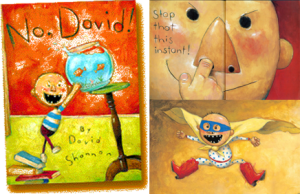 Putting a lesson together to teach the concept of “expected/ unexpected behaviors” using “No David!” would be fairly easy for most experienced clinicians. However, for me, having the resource list of children’s books that teach specific Social Thinking concepts makes Audra Jensen’s book an incredibly handy tool. An additional benefit of using children’s literature as a tool is that lessons can be planned for individual (one-on-one sessions) as well as groups.
Putting a lesson together to teach the concept of “expected/ unexpected behaviors” using “No David!” would be fairly easy for most experienced clinicians. However, for me, having the resource list of children’s books that teach specific Social Thinking concepts makes Audra Jensen’s book an incredibly handy tool. An additional benefit of using children’s literature as a tool is that lessons can be planned for individual (one-on-one sessions) as well as groups.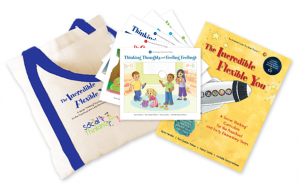 The area of language disorders that seemed to confound most therapists, including myself, for a long time was social skills or pragmatics. That was until I discovered Michelle Garcia Winner’s work. When I read her book “Thinking About YOU, Thinking About ME,” I finally felt relief. I started thinking about social skills in a completely different way that made sense. I realized that the reason my therapy tools didn’t seem powerful or effective was because I was focusing on teaching specific skills (e.g. How to start a conversation) in a specific situation (e.g. When you meet your neighbor), rather than teaching social thinking or social cognition. As a clinician, when you teach a specific skill in an artificial environment, the student may do well to learn the skill. But the questions “What happens when the situation changes? Can my student generalize this skill to another environment?” always haunted me. The knowledge that you can build a child’s perspective taking ability, or his ability to “listen with his whole body” to help him across situations and contexts, was my Eureka moment.
The area of language disorders that seemed to confound most therapists, including myself, for a long time was social skills or pragmatics. That was until I discovered Michelle Garcia Winner’s work. When I read her book “Thinking About YOU, Thinking About ME,” I finally felt relief. I started thinking about social skills in a completely different way that made sense. I realized that the reason my therapy tools didn’t seem powerful or effective was because I was focusing on teaching specific skills (e.g. How to start a conversation) in a specific situation (e.g. When you meet your neighbor), rather than teaching social thinking or social cognition. As a clinician, when you teach a specific skill in an artificial environment, the student may do well to learn the skill. But the questions “What happens when the situation changes? Can my student generalize this skill to another environment?” always haunted me. The knowledge that you can build a child’s perspective taking ability, or his ability to “listen with his whole body” to help him across situations and contexts, was my Eureka moment.